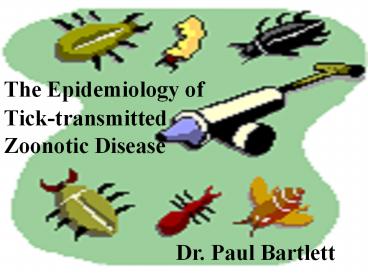The Epidemiology of Tick-transmitted Zoonotic Disease - PowerPoint PPT Presentation
Title:
The Epidemiology of Tick-transmitted Zoonotic Disease
Description:
The Epidemiology of Tick-transmitted Zoonotic Disease Dr. Paul Bartlett ... – PowerPoint PPT presentation
Number of Views:210
Avg rating:3.0/5.0
Title: The Epidemiology of Tick-transmitted Zoonotic Disease
1
The Epidemiology of Tick-transmitted Zoonotic
Disease
Dr. Paul Bartlett
2
Kenji Sato catching flies Organic dairy farm
study in the Kickapoo River Valley of Wisconsin
3
Grazing organic dairy cows. Kickapoo River
Valley,Wisconsin
4
Introduction
- In the USA, ticks can carry tularemia, Rocky
Mountain Spotted Fever (RMSF), Lyme Disease,
Colorado tick fever, Q fever, and tick-borne
relapsing fever. - These diseases can be transmitted to humans or
animals through the bite of an infected tick - Even though the bite wounds are small, tick bites
should be avoided because of the possibility of
the transmission of disease.
5
Prevention
- Long pants and long sleeves should be worn when
hiking or in tick infested areas - Insect repellent spray should be used on skin and
clothing - Pant legs should be tucked into socks to prevent
tick attachment - Tick checks should be preformed every 3 hours
when in infested areas - This is especially important because transmission
of some tick borne diseases can be prevented by
prompt removal of the tick.
6
Why are Veterinarians Involved?
- Wild animals are typically the natural
reservoirs, but domestic animals can bring
infected ticks into the homes of humans where
people can become exposed. - In this way domestic animals serve as the vector
of the vector for human tick transmitted
disease. - Tick control in domestic animals is a important
public health consideration and can be
accomplished through dips, powers, and sprays.
7
Removal of the Attached Tick
- The key in tick removal is to avoid crushing the
tick so that its body fluids will not contact
your skin or the hole in your skin made by the
bite. - Ticks should be removed using tweezers or fingers
protected by a gloves or a tissue. - Grasp the tick firmly and pull slowly and
steadily - Give him a choice of taking it (head) along or
leaving it behind. Pull slowly. Give him time to
think about it.
8
Lyme and Lyme-Like Disease
- Lyme Disease- Dr. Stobierski will talk about this
- Lyme-Like Disease - CDC is currently
investigating - Unknown infectious agent or it may be an atypical
type of immunologic reaction to the tick
proteins - Tends to be associated with the tick Amblyomma
americanum (Lone Star tick) - Cases often present with an erythema migrans-like
rash without a fever - This disease responds well to
- antibiotics.
Lone Star tick
9
Ehrlichia
- There are two ehrlichioses causing disease in
humans. 500 cases of both have been reported
since 1985.
10
Ehrlichiolses
- Human Monocytic Ehrlichiosis (HME) - infects
mononuclear phagocytes - Etiological agent- Ehrlichia chaffeensis
- Vector- Lone Star tick Amblyomma americanuum
- Seen in Southeastern and South central US
11
Ehrlichiolses
- Human Granulocytic Ehrlichiosis (HGE) - infects
granulocytes (neutrophils) - Unknown etiological agent (maybe E. equi)
- Vector- Black-legged ticks
- Usually more severe and acute than HME and
sometimes with a fatal febrile syndrome
Blacklegged tick (Ixodes scapularis)
Western blacklegged tick (Ixodes pacificus)
12
Human Erlichiolses (cont)
- They are clinically indistinguishable and cause
fever, renal failure, respiratory in sufficiency,
CNS problems, headache, myalgia, nausea, vomiting
and infrequently a rash. Can look similar
clinically to RMSF with out the rash - 500 cases reported in US since 1985
- Co-infections with HGE, Babesia microti, other
Babesia, and Lyme disease can be serious.
13
Colorado Tick Fever
- 200 - 300 cases of this disease occur each year
in the mountainous areas of the Northwestern US. - The disease is characterized by fever, chills,
headache, and muscle pain. - It is usually mild in adults but can be sever in
approximately 15 of effected children.
14
Rocky Mountain Spotted Fever (New World Spotted
Fever) (Tick-borne typhus)
- There are about 1,000 cases of RMSF reported each
year in the US. - Most cases of RMSF occur in the South Atlantic
States of Virginia, Tennessee, Georgia, North and
South Carolina. - The victims are most often young males who
contract the disease between April and September. - Rickettsia rickettsii is the etiological agent
for the disease.
15
photo provided courtesy of Rocky Mountain
Laboratories, NIAID, NIH, Hamilton, Montana)
16
Reported cases of Rocky Mountain spotted fever in
the United States, 1942-1996
17
Seasonal distribution of reported cases of Rocky
Mountain spotted fever, 1993-1996
18
RMSF Geographical Distribution
19
Number of reported cases of Rocky Mountain
spotted fever by state and region, 1994-1998
20
Late (petechial) rash on palm and forearm
Early (macular) rash on sole of foot
21
Vectors for RMSF
- Dermacentor andersonia is the vector in the
western part of the US - The American Dog tick (Dermacentor variabilis) is
the vector in the southeast part of the US. - Larva and nymphs feed on wild rodents while the
adults feed of larger mammals and possibly humans
or domestic dogs. - Upon attachment, a 5 to 20 hour
reactivation time is required
before the agent
can enter the
host.
American Dog tick
22
RMSF in Humans
- Incubation period is 2-12 days
- Symptoms include sudden onset, high fever,
nausea, vomiting, headache, chills, muscle pain
in the lower back and legs. - A diagnostic maculopapular rash can be
seen in 50 of the
patients and usually
starts at the wrist and ankles and
moves to the trunk. It often
involves the soles and palms.
23
RMSF in Animals
- Dogs
- Most of the time the disease is sub-clinical.
Sentinals. - Some dogs can have fever, anorexia, vomiting,
diarrhea, depression, conjunctivitis, mucopurlent
oculonasal discharge, cough and petechial or
ecchymotic hemmorrages on the ocular, oral, and
genital mucous membranes. - Humans are sometimes infected by removing ticks
from pet dogs































